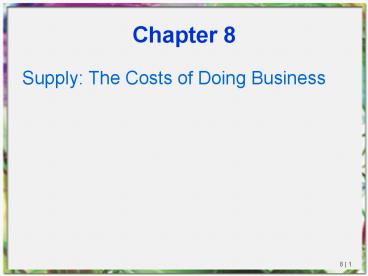Supply: The Costs of Doing Business PowerPoint PPT Presentation
1 / 15
Title: Supply: The Costs of Doing Business
1
Chapter 8
- Supply The Costs of Doing Business
2
Firms and Production
- The quantity of resources a firm uses and the
amount spent on selling activities depends on how
much they contribute to the value of the firm. - In general, the more the firm wants to supply the
more resources it must have. - Output and Resources
- Supply is the quantities of output that sellers
are willing and able to offer for sale at every
price. - To determine how much to supply at any given
price, sellers must know how much it costs to
supply each quantity.
3
Diminishing Marginal Returns
- The law of diminishing marginal returns
- When successive equal amounts of a variable
- resource (L) are combined with a fixed amount
- of another resource (say, K), marginal physical
- output due to the variable input (MPL?Q/?L)
- increases but will eventually decline as more
- of a variable input is added.
4
Short Vs Long Run in Production
- Short-run (SR) Qf( L,K), i.e. only these inputs
are a - constrain. But assume K is fixed, so that the
production - function, Qf(L), expresses various amounts of L
- combined with fixed K Idea in SR, management
has - limited flexibility in controlling costs since K
is fixed only L - is variable.
- Implication TC (w x L) (r x K) VC FC
- Long-run (LR) Qf( L,K), i.e. only these inputs
are a - constraint on a firms profit-maximizing
objective. Now K is variable, so - that the production function, Qf(L,K) ?
flexibility for management to - combine various L K to minimize costs profit
maximization. - Implication TC (w x L) (r x K) VC. There
are no FC in the LR.
5
Average Total Costs
- Average Total Costs ATC TC/Total Output
- Average total cost (ATC) the per unit cost
derived by dividing total cost by the quantity of
output. - Plotting the cost on the vertical axis and
quantity of output on the horizontal axis
generates the ATC curve.
6
Marginal Costs
- MC?TC/ ?Q ?VC/?Q since ?FC/ ?Q0
- When MCgtATC -gtATC?
- When MCltATC -gtATC?
- Upwards-sloping MC cuts the ATC at its minimum
7
Average and Marginal Costs
8
Definition of Costs Qf( L), K is fixed
- Total Costs (TC) -- the expenses a business has
in supplying goods and/or services. - Total Fixed Costs (TFC) -- payments to resources
whose quantities can not be changed during a
fixed period of time the short run e.g. TFC
r x K - Total Variable Costs (TVC) -- payments for
additional resources used as output increases
e.g. TVC w x L - Average Fixed Cost -- the total fixed cost
divided by total output AFC TFC/Q - Average total Cost (SRATC) -- the total cost of
production divided by the total quantity of
output produced when at least one resource is
fixed SRATC (TFCTVC)/Q - Average Variable Cost -- total variable cost
divided by total output e.g. AVC TVC/Q
9
Costs for the Airline Industry
- Suppose TC TFC TVC Fuel Costs New
- Seat Technology
- In response to higher fuel (fixed) costs, airline
carriers are taking advantage of new seat
technology (variable costs). e.g. Airbus seats - By using the stronger, lighter materials for
seats, airlines have been able to add as many as
12 extra seats to the coach section of their
planes, adding millions of dollars to their
annual revenues. - Result Higher revenues but dissatisfied coach
fliers
10
Time in Economics Short vs. Long Run
- The short run refers to any period of time during
which at least one resource can not be changed. - In the long run, everything is variable nothing
is fixed. - The most important difference between the short
run and the long run is that the law of
diminishing marginal returns does not apply when
all resources are variable. - Economics of Scale Scale means size.
- Economies of scale the decrease in per unit
costs as the quantity of production increases and
all resources are variable - Diseconomies of scale the increase in per unit
costs as the quantity of production increases and
all resources are variable - Constant returns to scale unit costs remain
constant as the quantity of production is
increased and all resources are variable
11
Short-Run and Long-Run Average-Cost Curves
- Economies of Scale and Long-Run Cost Curves
- In the long run, a firm has many sizes to choose
from. - The short run requires that scale be fixed only
one or a few resources can be changed.
12
Long-Run Average Total Cost
- Long-run average total cost (LRATC) the
lowest-cost combination of resources with which
each level of output is produced when all
resources are variable. - The long-run average total cost curve gets its
shape from economies and diseconomies of scale. - Shape of LRATC
- If producing each unit of output becomes less
costly there are economies of scale. - If producing each unit of output becomes more
costly there are diseconomies of scale. - If unit costs remain constant as output rises
there are constant returns to scale.
13
Long-Run and Short-Run Cost Curves (1)
14
Long-Run and Short-Run Cost Curves (3)
15
Minimum Efficient Scale
- Most industries experience both economies and
diseconomies of scale. - The minimum efficient scale (MES) is the minimum
point of the long-run average-cost curve the
output level at which the cost per unit of output
is the lowest. - The MES varies considerably across industries.

